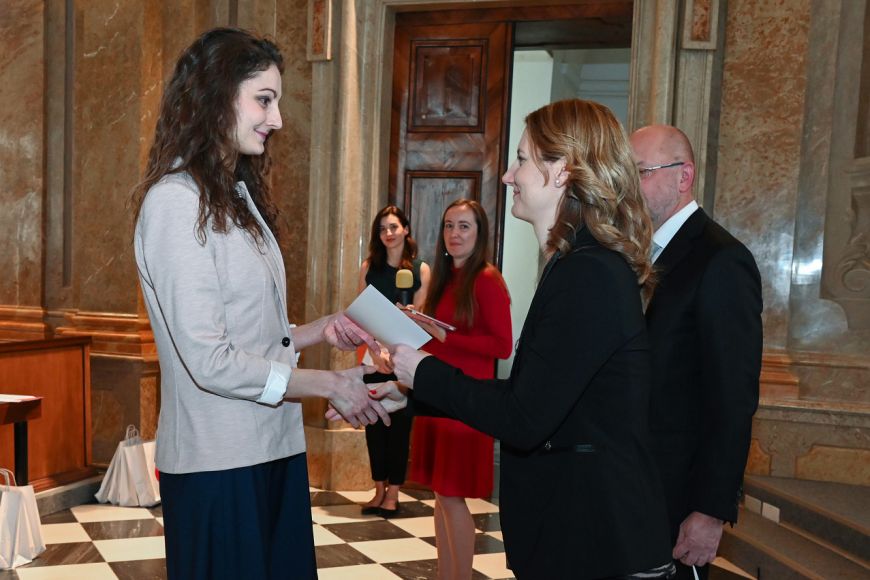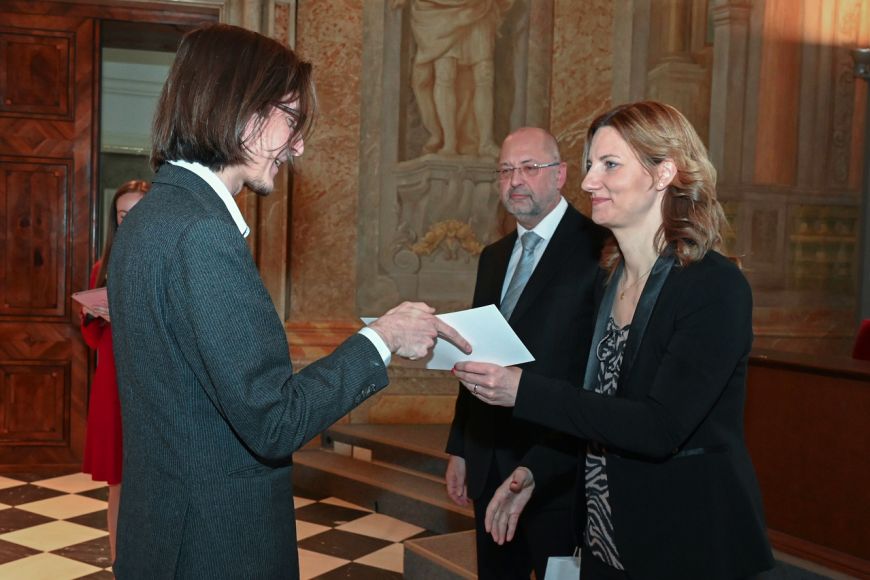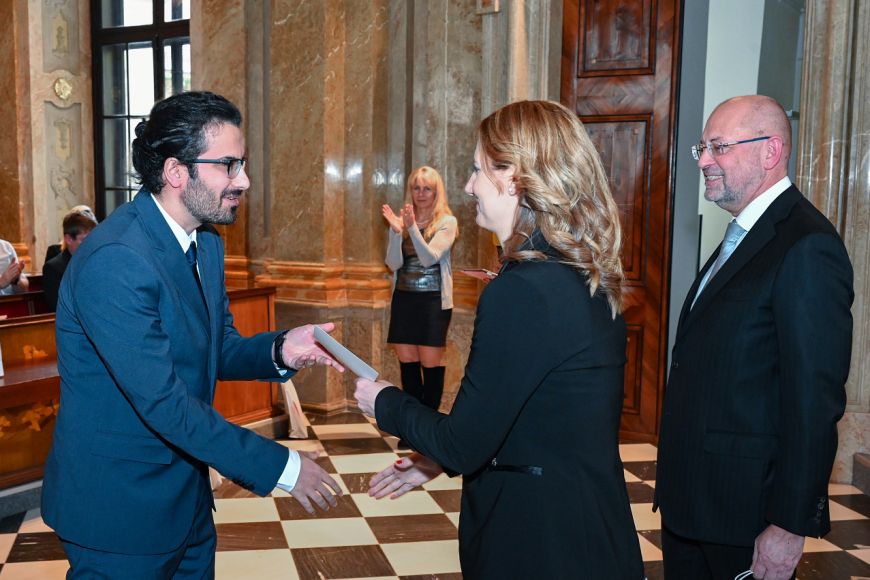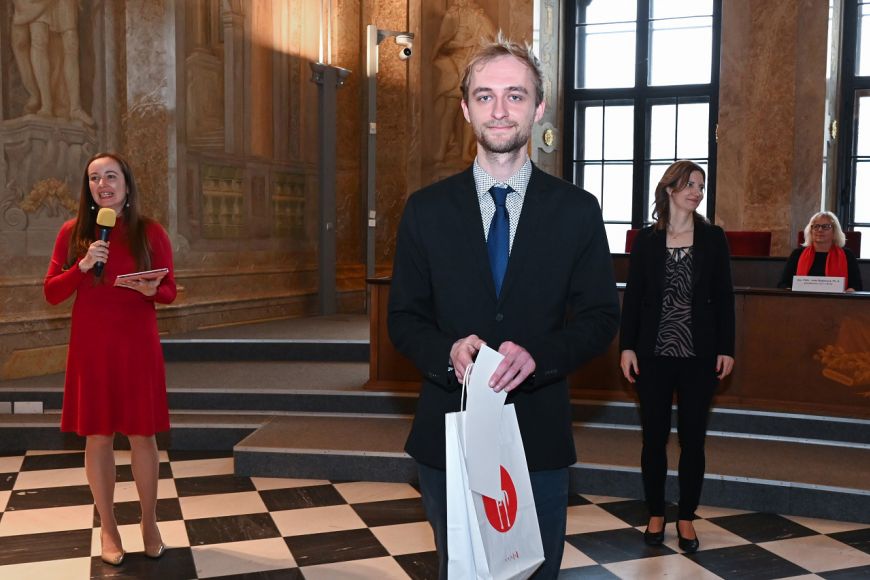A total of 145 applications were sent to Brno Ph.D. Talent 2022. Among the 25 students in the first year of doctoral programmes were 14 young scientists from Masaryk University. A jury of top scientists from the Czech Republic and abroad evaluated the projects and the finalists themselves.
Selected students will receive over seven million crowns over the next three years. Their projects are linked to South Moravia and Brno in particular. “Since its beginning, the programme has supported over 230 top-quality teams; it helped many young scientists start their career and supported efforts in research that reach beyond South Moravia and Brno,” said Brno Mayor Markéta Vaňková during the ceremony on 15 March 2022.
The grant is among the key criteria considered by recipients with respect to their career choices. Without it they would often choose to leave for the private sector and science would gradually be losing talent.
“This unique competition, entirely in English, motivates talented young scientists for doctoral studies and help form key personalities in science and supports the scientific community of excellent local researchers,” says Deputy Mayor of the City of Brno Tomáš Koláčný.
This year’s recipients include students of the Faculty of Medicine of Masaryk University Zita Goliášová who specialises in neurosciences in her doctoral studies. “The aim of my project is to explain mechanisms affecting the onset of epileptic seizures at the molecular level,” she explains. “I have always been drawn to biology. I like the fact that it allows us to “peek behind the curtain” to see things on which the functioning of all organisms depends, including humans. I can use the newly acquired knowledge in practice and maybe even help people one day. Also science asks countless interesting questions and represents many challenges that have the potential of improving our society.”
Brno Ph.D. Talent 2022 – students of Masaryk University among those recognised:
Daniela Brenner – Faculty of Science – Metabolomic and toxicokinetic in vitro approach for studying chemically-induced chronic liver diseases
Project details: Acute or long-term exposure of the human body to chemicals can result in acute or chronic liver disease, such as non-alcoholic fatty liver disease (NAFLD). The project will ensure in-depth understanding of chemical behaviour and intracellular effects of PFC and cyanotoxins via 3D in vitro models. It will also yield information on their potential to cause chronic liver disease and focus on related mechanisms based on changes in the metabolic profile.
Jakub Sumbal – Faculty of Medicine – Fibroblast-intrinsic FGF, WNT and NOTCH signalling in mammary epithelial morphogenesis
Project details: Organ formation is a fundamental question in developmental biology. Signals from the surrounding environment are a key control element for the developing organ, and similar signals which promote growth can be subject to undesirable use by a growing tumour. I am trying to find out how three signalling pathways (referred to as FGF, WNT and NOTCH) regulate the biology of fibroblasts – i.e. main cells of the microenvironment of growing organs.

Yusuf Lodhi – Faculty of Medicine – Identification of novel means to overcome resistance to Venetoclax in AML
Project details: Acute myeloid leukaemia (AML) is an illness with low probability of survival and limited treatment conditions, based mainly on chemotherapy. Venetoclax is a promising new BCL-2 inhibitor whose effects suffer from resistance. We identify, through the profiling of pharmaceutical products and CRISPR/Cas9 screening, the drugs capable of synergy with venetoklax, or those capable of reversing its resistance. This can reveal unique objectives for new effective targeted therapy and the achievement of stronger responses, compared to Venetoclax as sole treatment.

Zita Goliášová – Faculty of Medicine – The function of microRNA in the epileptic brain
Project details: Temporal lobe epilepsy is among the most common types of epileptic seizures, with strong drug resistance and resulting complications in the course of treatment. The aim of my project is to explain the mechanisms that affect the onset of seizures at the molecular level. In particular, I focus on the action of microRNA whose level fluctuations significantly affect neuronal excitability. The identification of the function and specific targets of microRNA would be a major step in the treatment of the illness.
Volodymyr Porokh – Faculty of Medicine – Molecular mechanisms determining genetic (in)stability in the mammalian zygote
Project details: Despite major scientific advances in reproductive medicine the development of embryos is still a mystery. The way in which the cell cycle mechanism is altered to allow the union and segregation of the two parental genomes in the fertilised egg is essential to all mammals. The proposed project shall explain how fundamental cell cycle mechanisms are adjusted in the transition from acentrosomal female meiosis to mitotic division, where centrioles from the male gamete take control of microtubule organisation.

Matea Brezak – Faculty of Medicine – Decoding ERK signalling patterns underlying physiological and cancerous cell behaviour
Project details: The development of new treatment procedures in breast cancer patients requires the understanding of fundamental cellular mechanisms behind the development of the mammary gland. ERK is a major signalling node associated with different behaviour of cells under normal conditions of development and in the case of cancer. My research shall utilise advanced biosensor systems, 3D organoid cultures, state-of-the-art imaging techniques and molecular biology procedures in the study of ERK associated with breast development and the initiation and progression of cancer.

Vincent Jongen – Faculty of Medicine – Development of microfluidic systems for the modelling of lung tissue
Project details: Advances in stem cell research have led to the development of 3D in vitro models (organoids). Organoids allow for the partial recapitulation of selected aspects of lung tissue, but significant limitations are still present (such as the lack of tissue architecture or concentration gradients of signalling molecules). The aim of the project is to develop a microfluidic piece of equipment that combines lung and endothelial progenitors to overcome these issues and control lung tissue morphogenesis in controlled micro-environment.

Karolína Smolková – Faculty of Medicine – Targeting the eIF4F complex to overcome melanoma resistance to BRAF and MEK inhibitors
Project details: Malignant melanoma is an aggressive type of cancer whose growth is driven by oncogenic mutations which hyperactivate the ERK signalling pathway. Highly effective inhibitors target members of this pathway. Soon the illness returns as resistance develops. In my project I shall focus on better understanding of the mechanisms behind resistance, especially the link between ERK signalling and the increased activity of the eIF4F complex. Also, the aim of my project is to identify and describe novel inhibitors of the complex.

Miriam Sandanusová – Faculty of Science – Study of extracellular vesicles in the gastro-intestinal tract as a novel approach to inflammatory bowel disease treatment
Project details: Chronic inflammatory bowel diseases (Crohn’s disease and ulcerative colitis) cause serious health problems. They are accompanied by imbalance of the microbiome which leads to changes in the structure and production of microbial extracellular vesicles. In this project we shall focus on them as, in our opinion, they can be an appropriate therapeutic goal in pharmaceuticals development – treatment could include the prevention of absorption of pro-inflammatory extracellular vesicles into the organism.

Kristóf Kanalas – Faculty of Science MU – A model structure for geometric categories
Project details: The aim of the project is to describe potential structures of Quillen models on (2,1)-category of small coherent categories and look for the application in categorical logic. Particular attention is paid to model structure induced by the 2-reflective full subcategory of pretopoi.
Petr Kouba – Faculty of Science MU – The Study of the Interactions between the Amyloid Beta Peptide and Small Molecules by Molecular Dynamics and Artificial Intelligence
Project details: It is believed that Amyloid Beta Peptide plays a key role in the onset of Alzheimer’s disease. The study of this peptide and its interactions with small molecules could greatly benefit the treatment of the disease. The key challenge in the study of the Amyloid Beta Peptide arises from the fact that it is a disordered protein that lacks a fixed structure. To this end, we shall use the simulation of molecular dynamics, using machine-based learning for the subsequent analysis of these simulations.
Lucie Seidlová – Faculty of Science – Patterns and processes in structuring parasite populations: roles of host specificity, dispersal capabilities, and complexity of life cycle
Project details: The project focuses on the study of population structure of fish parasites using morphologic and genetic approaches. New genetic forms of parasites pose a potential risk for the host population. Population fragmentation can result in the extinction of endangered species, with significant consequences for ecosystems and the overall balance of biodiversity. To this end, I shall study the factors affecting the population structure. Included in the project is the proposal of new molecular markers to be potentially used in future studies.

Farshad Nejat – Faculty of Science MU – Host-specific parasites highlight the role of the Middle East in their cyprinoid hosts dispersion and diversification
Project details: This project aims to study the diversity and phylogenesis of monogeneans as parasites in cyprinoid hosts from the Middle East. It represents the largest historical area of the exchange of species among the Asia, European and African continents. Monogeneans will be applied as an additional tool for the identification of (1) historical contacts of the carp family between the Middle East and Mediterranean and (2) contemporary contacts within Cyprinidae.

Petr Janás – Faculty of Science MU – CRISPR/Cas-based editing of plant genomes: An exciting journey from the study of chromosome evolution to increasing the quality and yield of key crops
Project details: The aim of the project is the induction of chromosome rearrangements via CRISPR/Cas which have occurred throughout the evolution and speciation of Brassicaceae. CRISPR/Cas is a multi-purpose genetic engineering technology. Through the induction of two and more double-stranded breaks CRICPR/Cas can be used for the creation of major chromosome rearrangements (inversion, translocation, deletion–), and by doing so, to replay the tape of evolution.
The grant in the amount of CZK 9 million was provided by the City of Brno; the project is part of the Regional Innovation Strategy and its implementation is administered by JCMM which actively communicates with the selected doctoral students. “The growing interest in participation in the Brno Ph.D. Talent project proves the improving quality of science and research in Brno. The programme is a success thanks to ongoing support from the City of Brno. Many doctoral studies come to Brno from foreign countries and they often stay, which further fuels the improvement of research in the region,” says Miloš Šifalda, Director of JCMM.
